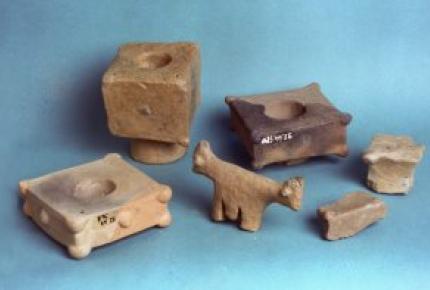The archaeological collection of Göcseji Museum holds finds which originate from the period ranging from the Paleolithic to modern times and were found in the northern and south-west areas of Zala county.
When the museum was founded only one professional ethnographer worked in the institution. During his collecting tours he also recorded the data of archaeological sites and brought the finds there to the museum. When the archaeological sites were disarranged due to some earth-work he called professionals who excavated and rescued the keepsakes of old times. As a result of this activity the modest collection of 81 pcs from earlier collections was multiplied by twenty in ten years. In the life of our museum the first big planned excavation which lasted for years was realized on a site which used to be an Avar cemetery in Pókaszepetk; this material of finds constituted the most significant part of the archaeological collection for a long period of time.
Archaeologists have been employed by the Göcseji Museum since 1962. Regular research work started at that time: discovering archaeological sites through field trips, monument excavations and planned excavations. From the beginning of the 1970s several research programs of national interest were in progress in Zala county. These partly took place at the collection site of Göcseji Museum and the colleagues of our institution participated in all of them. The bulk of the material of finds that came out increased our archaeological collection.
The search for the Roman Salla city in Zalalövő took place between 1973 and 1989 under the direction of the Archaeological Department of Eötvös Lóránd University. The excavated buildings and finds can be viewed in Salla Museum established in Zalalövő. Between 1979 and 1985 the colleagues of the Directorate of Zala County Museums and the Archaeological Institute of the Hungarian Academy of Sciences carried out archaeological excavations prior to the project in the Reservoir I. area of Kis-Balaton. The representative summary of the results of the research was published in the book titled “The Message of Millennia from the Moorland”.
Between 1987 and 1994 researches into the history of settlements were in progress in the neighbourhood of Hahót. The material of finds excavated by the associates increased the Archaeological Collection of Göcseji Museum. Between 1995 and 1999 there were similar researches into the history of settlements organized along river Kerka.
Pre-excavations took place along the Hungarian-Slovenian railway tracks, in Zala Valley. The excavations enriched our collection with matchless finds.
Excavations prior to the project started in 1999 along highway M70 and motorway M7. All the archaeologists of the Göcseji Museum have joined these works. The latest results are available for the public. Between 2002 and 2005 the pre-excavations by road 76 along the bypass north of Zalaegerszeg took place. Besides growing the Archaeological Collection, the material of finds that came out significantly increased our knowledge about the history of the town. Today there are more than 150 thousand finds registered. Our data have also been recorded on our computerized database.
In the past few years, we have carried out several excavations in Zala county. In Vállus the primary purpose of the excavation was to determine the full length of the church and the way the sanctuary was added to the monastery. During the research work we were faced with some “surprises” which threw a new light upon the results of former excavations.
Our archaeologists started the excavation of the Premonstratensian Monastery in Türje, in 2018. Keepsakes from the middle ages and from two other eras came out from the hill above river Nádas. There lived people on the site of the quondam convent both in the prehistoric age and in the Roman times. The prime objective of our research was to reconstruct the ground-plan and the history of the construction of the monastery founded during the Árpád dynasty.
Göcseji Museum announced its cooperation program with civilian people working with metal detector a few years ago. We expected people who want to use their metal detector legally in collaboration with the museum to join the program. The mutual work has resulted in several beautiful finds from the Roman times.
In the spring of 2017, in the Zala county seat the establishment of an automotive industry test track began on about 250 acres which will, among other things, facilitate the researching and testing of electric and self-driving cars in the future. Just like in the case of all huge projects, the construction of the Zalaegerszeg Automotive Industry Test Track was also preceded by archaeological pre-excavations. The area around the test track was intact on the map of the archaeologists because it had functioned as a military shooting ground, so no research was allowed. The huge suburban area was probed by trenches in the beginning and as a result three ancient cultures were discovered. The oldest objects verified the presence of Lengyel culture at the end of the Neolithic age. The remains of a settlement consisting of 20-30 houses on several acres were outlined due to the tracks of buildings from the time of 6500-7000 years ago. The population that used to live here mined clay and refilled the pits arisen from mining with trash which is a real goldmine for archaeologists. Chipped-stone tools, bone artefacts, ceramic artefacts, clay bowls in a relatively good condition were excavated, and a palm-sized female idol was found as well, probably it was the medium of the symbolic rituals of the community. Ceramic pieces painted with geometric patterns and a remain of a stone-axe were also uncovered from the earth. The area was also populated in the late Copper Age and in the Bronze Age, the embellishments characteristic of the age on the excavated broken pieces of the bowls where the patterns became visible only after the restoration witness this. The number of finds gradually keeps growing. Among other things fancy ceramics from the Bronze Age, scratched stones, fragments of stone-axes, clay spoons, remains of cultic objects were also hidden deep down in the earth.

